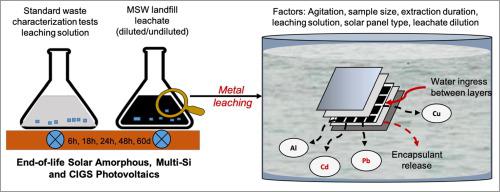Waste Management ( IF 7.1 ) Pub Date : 2021-02-10 , DOI: 10.1016/j.wasman.2021.01.013 Preeti Nain , Arun Kumar

|
The upcoming end-of-life solar photovoltaics (PV) waste stream is a huge concern before solid waste professionals due to presence of hazardous metals like lead or cadmium. The objective of present study was to understand the metal dissolution from PVs under four standard waste characterization regulatory tests of U.S., Germany, and Japan and their representativeness with actual landfill leachate. Modules were exposed to real municipal solid waste (MSW) landfill leachate for extended extraction duration, agitation and diluted leachate to investigate the effect of various parameters on metal dissolution. The results indicated that extractions using landfill leachates resulted in lower metal release than standard methods. The leached metal concentrations were found to be within the threshold limits except for cadmium, copper, lead and selenium, with maximum lead release from amorphous-PV of 8.68 mg/L and 6.91 mg/L with respect to TCLP and WET tests, respectively. Arsenic showed negligible release with maximum concentration of 0.046 mg/L from copper indium gallium de-selenide(CIGS) PV. Regardless of small size (1–2 cm pieces) and agitation, Germany and Japan’s standard tests resulted in minimal release except of copper from copper indium gallium de-selenide PV. Leaching without agitation, showed negligible release from all photovoltaics whereas when agitation is applied to diluted leachate, significant release was observed with aluminum and copper leached up to 145.32 mg/L (multi-crystalline silicon) and 139.01 mg/L (amorphous-PV), respectively. CIGS was found to be most hazardous with a Metal Hazard Score (calculated on the basis of magnitude of leached metals with respect to their threshold limit and subsequent health effects) of 23.19, when exposed to standard tests. For all scenarios, increased metal release was observed with decrease in sample size and increase in leachate dilution and thus, leaching in highly acidic conditions are by no means representative for modules dumping in realistic conditions.
中文翻译:

了解在标准废物表征条件下太阳能光伏废液中太阳能光伏中的金属溶解情况,以告知报废光伏废物管理
由于铅或镉等有害金属的存在,即将到来的报废太阳能光伏(PV)废物流成为固体废物专业人员之前的巨大关注。本研究的目的是了解在美国,德国和日本的四个标准废物表征法规测试下,PVs中金属的溶解度及其在实际垃圾渗滤液中的代表性。将组件暴露于实际的城市固体垃圾(MSW)垃圾渗滤液中,以延长提取时间,搅拌和稀释渗滤液,以研究各种参数对金属溶解的影响。结果表明,与标准方法相比,使用垃圾填埋场浸出液提取可降低金属释放量。除镉,铜,铅和硒外,浸出的金属浓度均在阈值范围内,相对于TCLP和WET测试,无定形PV的最大铅释放量分别为8.68 mg / L和6.91 mg / L。砷从去硒化铜铟镓(CIGS)PV中的最大浓度为0.046 mg / L时,释放的微不足道。无论是小尺寸(1-2厘米小块)和搅拌,德国和日本的标准测试都将释放的影响降到最低,除了铜铟镓硒硒PV中的铜。在不进行搅拌的情况下进行浸出时,显示出所有光伏电池的释放量可忽略不计,而当对稀释的浸出液进行搅拌时,铝和铜的浸出量分别达到145.32 mg / L(多晶硅)和139.01 mg / L(非晶态PV)时,观察到显着释放。 , 分别。当暴露于标准测试中时,发现CIGS的金属危害分数(根据浸出金属的阈值限值和随后的健康影响而定)为23.19,是最危险的。在所有情况下,随着样品量的减少和浸出液稀释度的增加,观察到金属释放量的增加,因此,在高酸性条件下的浸出绝不能代表实际条件下的组件倾倒。











































 京公网安备 11010802027423号
京公网安备 11010802027423号